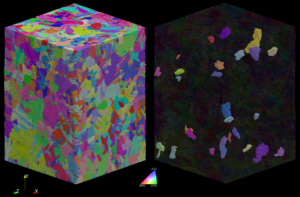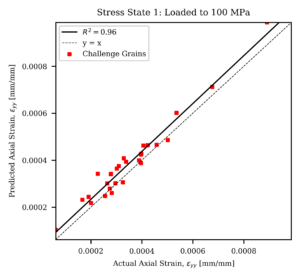
University of Utah mechanical engineering associate Professor Ashley Spear, undergraduate researcher Carter Cocke, Prof. Anthony Rollett from Carnegie Mellon University, and Dr. Ricardo Lebensohn from Los Alamos National Laboratory are a U led team and awardees of the America Makes and Air Force Research Laboratory (AFRL) Additive Manufacturing Modeling Challenge Series. The goal of the Challenge Series was to improve the accuracy of model predictions for metal, using INCONEL® nickel-chromium alloy 625 (IN625). The Utah team won the Micro-scale Structure-to-Properties Predictions challenge.
The challenge was launched in November 2019 and comprised of four individual challenges divided between macro-scale and micro-scale, as well as process-to-structure and structure-to-properties predictions. Challenge participants were provided high-pedigree calibration and validation data sets needed to develop new models as it directly related to predicting the internal structure and resultant performance of AM metallic components.

Spear and colleagues worked to predict the strain components of specific “challenge grains” within a microstructure at 6 macroscopic stress states. The team was given the texture of the initial state and the global/macroscopic stress-strain response to use for predictions. The 6 strain components (1 axial, 2 transverse, and 3 shear components), 6 incrementally larger macroscopic stress states, and 28 challenge grains required a total of 1008 predictions. Of those predictions, Spear’s team had the lowest overall error compared to actual values.
Spear and Cocke began working on the challenge in November, but initially were unsure they would be able to match the loading scenario of the challenge due to the multiple unloading steps needed. The team worked with Rollett and Lebensohn, both experts in the crystal plasticity code (EVPFFT), to develop their predictions.
“These results are great news for the FFT-based approach we used, which is less widely used than the FEM-based method,” said Cocke. “This entire experience has been extremely valuable in improving our modeling abilities, and we have since identified a few improvements to our model that we can carry forward.”
Visit the Multiscale Mechanics and Materials Laboratory website to learn more about Spear’s work.